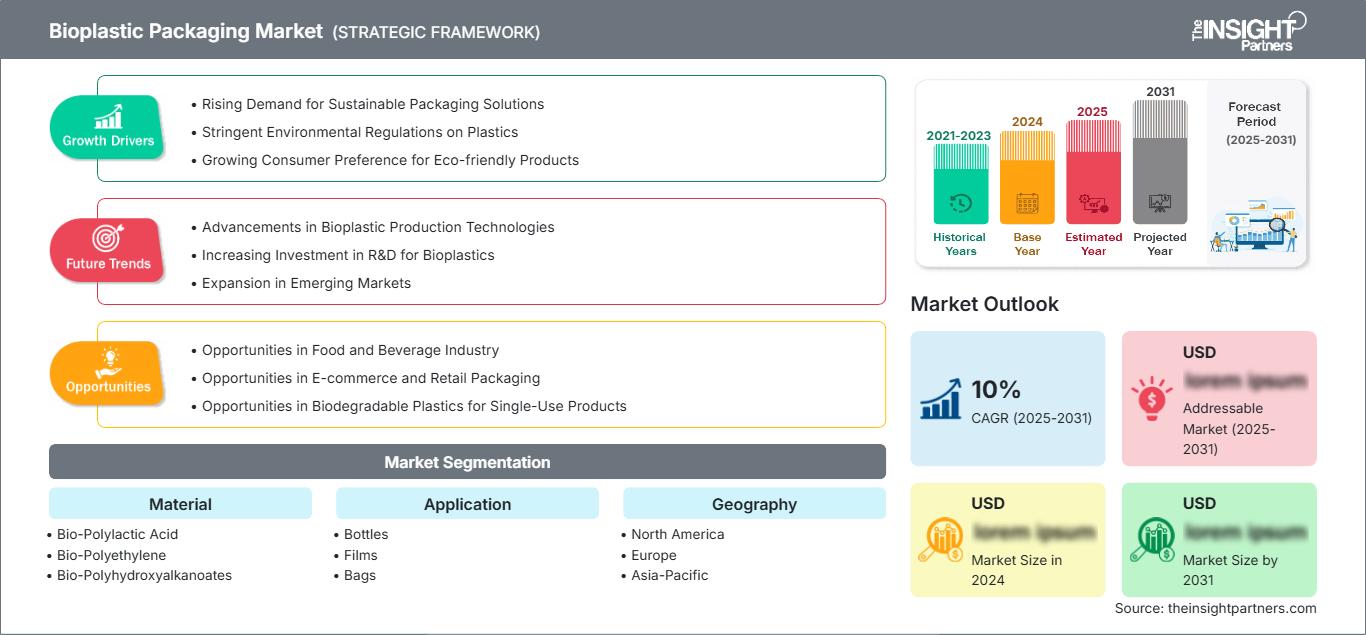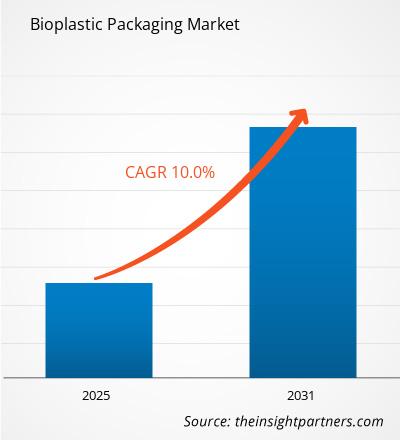Se espera que el tamaño del mercado de envases bioplásticos alcance los 54.240 millones de dólares estadounidenses para 2031. Se anticipa que el mercado registre una CAGR del 15,7 % durante 2025-2031.
El informe presenta un análisis basado en el material (ácido biopoliláctico, biopolietileno, biopolihidroxialcanoatos, biotereftalato de polietileno, entre otros). El informe está segmentado por aplicación (botellas, películas, bolsas, sobres, vasos y bandejas, entre otros). El informe presenta un análisis basado en el uso final (alimentos y bebidas, cosméticos y cuidado personal, productos farmacéuticos y nutracéuticos, bienes de consumo, entre otros). El análisis global se desglosa a nivel regional y por países principales. El tamaño del mercado y el pronóstico a nivel global, regional y nacional para todos los segmentos clave del mercado están cubiertos bajo el alcance. El informe ofrece el valor en USD para el análisis y los segmentos anteriores. El informe proporciona estadísticas clave sobre el estado del mercado de los principales actores del mercado y ofrece tendencias y oportunidades del mercado.
Propósito del Informe
El informe "Mercado de Envases Bioplásticos" de The Insight Partners busca describir el panorama actual y el crecimiento futuro, los principales factores impulsores, los desafíos y las oportunidades. Esto proporcionará información a diversas partes interesadas del negocio, como:
- Proveedores/fabricantes de tecnología: Para comprender la dinámica cambiante del mercado y conocer las oportunidades potenciales de crecimiento, lo que les permitirá tomar decisiones estratégicas informadas.
- Inversores: Realizar un análisis exhaustivo de tendencias respecto a la tasa de crecimiento del mercado, las proyecciones financieras del mercado y las oportunidades que existen en toda la cadena de valor.
- Órganos reguladores: Regular las políticas y las actividades policiales en el mercado con el objetivo de minimizar el abuso, preservar la confianza de los inversores y defender la integridad y estabilidad del mercado.
Segmentación del mercado de envases de bioplástico
- Ácido biopoliláctico
- Biopolietileno
- Biopolihidroxialcanoatos
- Tereftalato de biopolietileno
Solicitud
- Botellas
- Películas
- Bolsas
- Bolsa y sobre
- Tazas y bandejas
Obtendrá personalización en cualquier informe, sin cargo, incluidas partes de este informe o análisis a nivel de país, paquete de datos de Excel, así como también grandes ofertas y descuentos para empresas emergentes y universidades.
Mercado de envases bioplásticos: perspectivas estratégicas

-
Obtenga las principales tendencias clave del mercado de este informe.Esta muestra GRATUITA incluirá análisis de datos, desde tendencias del mercado hasta estimaciones y pronósticos.
Factores que impulsan el crecimiento del mercado de envases bioplásticos
- Creciente demanda de soluciones de embalaje sostenibles: La creciente demanda de envases ecológicos y sostenibles por parte de los consumidores es un factor clave en el mercado de los envases de bioplástico. Ante el aumento de los residuos plásticos y la preocupación por el medio ambiente, los bioplásticos, fabricados a partir de recursos renovables como materiales vegetales, ofrecen una alternativa biodegradable a los plásticos convencionales. Esta demanda de soluciones de embalaje sostenibles está impulsando a las industrias de alimentación y bebidas, comercio minorista y bienes de consumo a adoptar envases de bioplástico, impulsando así el crecimiento del mercado.
- Regulaciones ambientales estrictas sobre plásticos: Gobiernos de todo el mundo están implementando regulaciones más estrictas sobre residuos plásticos, contaminación y envases no biodegradables, lo que impulsa la demanda de bioplásticos. Políticas como la prohibición de plásticos y los programas de responsabilidad extendida del productor (REP) están animando a los fabricantes a optar por alternativas biodegradables y compostables. Los bioplásticos ofrecen una solución viable para cumplir con los requisitos regulatorios, impulsando el crecimiento del mercado de envases de bioplásticos a medida que las industrias buscan el cumplimiento de las normas ambientales.
- Creciente preferencia del consumidor por productos ecológicos: Existe un cambio creciente en las preferencias del consumidor hacia productos con un impacto ambiental mínimo. Los consumidores son cada vez más conscientes de la huella ecológica de los envases y buscan activamente productos con envases sostenibles. Esta creciente demanda de productos con conciencia ecológica impulsa a las marcas a optar por envases de bioplástico como parte de sus iniciativas de sostenibilidad, lo que contribuye al crecimiento general del mercado.
Tendencias futuras del mercado de envases bioplásticos
- Avances en las tecnologías de producción de bioplásticos: Los avances tecnológicos en la producción de bioplásticos están mejorando la viabilidad y el rendimiento de los envases de bioplásticos. Las innovaciones en las tecnologías de procesamiento están mejorando la eficiencia y la rentabilidad de los bioplásticos, haciéndolos más competitivos frente a los plásticos tradicionales. El desarrollo de nuevos polímeros de origen biológico, como el ácido poliláctico (PLA) y los polihidroxialcanoatos (PHA), con mayor durabilidad y funcionalidad, está impulsando el crecimiento y la adopción de envases de bioplásticos en diversas industrias.
- Aumento de la inversión en I+D para bioplásticos: La inversión en investigación y desarrollo (I+D) está creando nuevas oportunidades para el mercado de envases de bioplásticos. Los fabricantes se centran en el desarrollo de bioplásticos con propiedades mejoradas, como mayor resistencia, flexibilidad y resistencia a la humedad y al calor. Además, las iniciativas de I+D se centran en el uso de materias primas más sostenibles y de origen local para los bioplásticos. Estas innovaciones contribuyen a aumentar la versatilidad del mercado y a ampliar sus aplicaciones en el sector del envasado.
- Expansión en mercados emergentes: Las economías emergentes en regiones como Asia-Pacífico, Latinoamérica y África están experimentando un rápido crecimiento en la adopción de envases de bioplástico. La creciente concienciación sobre la contaminación plástica, sumada a las presiones regulatorias y los incentivos gubernamentales para envases sostenibles, está animando a las empresas de estas regiones a adoptar los bioplásticos. La creciente demanda de soluciones de envasado ecológicas en las regiones en desarrollo está creando importantes oportunidades de crecimiento para los fabricantes de envases de bioplástico.
Oportunidades de mercado para envases de bioplástico
- Oportunidades en la industria de alimentos y bebidas: Esta industria presenta importantes oportunidades para el mercado de envases de bioplásticos debido a la alta demanda de soluciones de envasado. Los bioplásticos ofrecen una opción sostenible para el envasado de productos alimenticios, con beneficios como la biodegradabilidad y la compostabilidad. A medida que las preferencias de los consumidores se inclinan por opciones de envasado más sostenibles, los bioplásticos se están volviendo cada vez más populares en el envasado de alimentos, lo que genera oportunidades de crecimiento para los fabricantes que se dirigen a esta industria.
- Oportunidades en el comercio electrónico y el embalaje minorista: Con el auge del comercio electrónico, crece la demanda de soluciones de embalaje sostenibles en el comercio minorista en línea. Los bioplásticos se perfilan como una opción viable para el embalaje del comercio electrónico gracias a sus características ecológicas. El creciente interés en reducir los residuos plásticos en los procesos de envío y embalaje está animando a los minoristas a adoptar alternativas a los bioplásticos, lo que crea una oportunidad lucrativa para la expansión del mercado en el sector del comercio electrónico.
- Oportunidades en plásticos biodegradables para productos de un solo uso: El mercado de alternativas a los plásticos de un solo uso presenta importantes oportunidades para los bioplásticos. Artículos como cubiertos, pajitas y materiales de embalaje se encuentran entre los plásticos de un solo uso más comunes, lo que contribuye a la generación de residuos plásticos. Ante la creciente demanda de alternativas por parte de gobiernos y consumidores, los bioplásticos ofrecen una solución biodegradable para estos productos. Esta transición hacia envases y productos sostenibles está impulsando el crecimiento de los bioplásticos en el mercado de los plásticos de un solo uso.
Perspectivas regionales del mercado de envases de bioplástico
Los analistas de The Insight Partners han explicado detalladamente las tendencias regionales y los factores que influyen en el mercado de envases bioplásticos durante el período de pronóstico. Esta sección también analiza los segmentos y la geografía del mercado de envases bioplásticos en América del Norte, Europa, Asia Pacífico, Oriente Medio y África, y América del Sur y Central.
Alcance del informe de mercado de envases de bioplástico
| Atributo del informe | Detalles |
|---|---|
| Tamaño del mercado en 2024 | XX mil millones de dólares estadounidenses |
| Tamaño del mercado en 2031 | 54.240 millones de dólares estadounidenses |
| CAGR global (2025-2031) | 15,7% |
| Datos históricos | 2021-2023 |
| Período de pronóstico | 2025-2031 |
| Segmentos cubiertos |
Por material
|
| Regiones y países cubiertos |
América del norte
|
| Líderes del mercado y perfiles de empresas clave |
|
Densidad de actores del mercado de envases bioplásticos: comprensión de su impacto en la dinámica empresarial
El mercado de envases bioplásticos está creciendo rápidamente, impulsado por la creciente demanda del usuario final debido a factores como la evolución de las preferencias de los consumidores, los avances tecnológicos y una mayor conciencia de los beneficios del producto. A medida que aumenta la demanda, las empresas amplían su oferta, innovan para satisfacer las necesidades de los consumidores y aprovechan las tendencias emergentes, lo que impulsa aún más el crecimiento del mercado.

- Obtenga una descripción general de los principales actores clave del mercado de envases bioplásticos
Puntos clave de venta
- Cobertura integral: el informe cubre de manera integral el análisis de productos, servicios, tipos y usuarios finales del mercado de envases de bioplástico, proporcionando un panorama holístico.
- Análisis de expertos: el informe se compila con base en el conocimiento profundo de expertos y analistas de la industria.
- Información actualizada: El informe asegura relevancia comercial debido a su cobertura de información reciente y tendencias de datos.
- Opciones de personalización: este informe se puede personalizar para satisfacer los requisitos específicos del cliente y adaptarse adecuadamente a las estrategias comerciales.
Por lo tanto, el informe de investigación sobre el mercado de envases bioplásticos puede ayudar a descifrar y comprender el panorama de la industria y sus perspectivas de crecimiento. Si bien existen algunas preocupaciones válidas, las ventajas generales de este informe suelen superar las desventajas.
- Análisis histórico (2 años), año base, pronóstico (7 años) con CAGR
- Análisis PEST y FODA
- Tamaño del mercado, valor/volumen: global, regional y nacional
- Industria y panorama competitivo
- Conjunto de datos de Excel
Informes recientes
Informes relacionados
Testimonios
Razón para comprar
- Toma de decisiones informada
- Comprensión de la dinámica del mercado
- Análisis competitivo
- Información sobre clientes
- Pronósticos del mercado
- Mitigación de riesgos
- Planificación estratégica
- Justificación de la inversión
- Identificación de mercados emergentes
- Mejora de las estrategias de marketing
- Impulso de la eficiencia operativa
- Alineación con las tendencias regulatorias






















 Obtenga una muestra gratuita para - Mercado de envases de bioplástico
Obtenga una muestra gratuita para - Mercado de envases de bioplástico